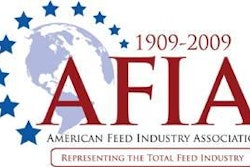
Feed enzyme sales are hot, with all manufacturers interviewed reporting brisk demand over the past year, with 2009 and 2010 expected to usher in even stronger sales numbers. Enzymes have gone from being a feed additive only used occasionally in diets in the United States “to suddenly become mainstream,” says John Geuss, director of marketing and business development for Adisseo.
For the United States, enzymes reached important market penetration in 2008, Geuss states, several years later than in Europe. The reason for that, he says, is that European livestock producers use more wheat and barley, and vegetable proteins in their rations, and had more to gain from enzymes historically than U.S. producers, the latter with their traditional corn, soybean mea and animal protein rich diets. But that all changed, he says, when corn (maize) went from $2 to $8 per bushel, and fat prices went from their long-term average of 13 cents per pound to in excess of 30 cents last year, even though prices have tapered off from that in recent months.
“Money talks,” Geuss says.” Adisseo used to say in its Rovabio MAX (combination degrading and phytase enzymes) ads that it its enzymes saved $3/ton, but last year the saving increased to $9 and now is at $6/ton, largely due to phosphorus going from $200/ton to $1,000, before backing off somewhat to $700/ton by early March 2009,” Geuss says.
Growing very fast
For the company A.B. Vista, the enzyme and yeast platforms “are growing very fast,” states Richard Cooper, managing director. One reason for the growth of the company’s flagship new xylanase product for corn-soy diets, Cooper says, is that the enzyme is not destroyed by heating up to 200 degrees F. Thus, it can be put through a commercial pellet press and can be easily analyzed post pelleting. This is essential as more feed companies demand good quality control, he says. “It is essential,” he continues, “that what we sell reduces feeding cost.” Cooper indicated that his company has increased production capacity. We needed to increase production to meet the increasing demand for its enzyme products.
While the spike in commodity prices has been an important reason for the enzyme market taking off, it’s not the only factor. Ingredient quality is also under pressure as corn and soybean meal are in shorter supply and more expensive. The result is that less digestible ingredients such as cassava are being fed in some markets. Enzymes can break down tougher fibers and make ingredients contained in them more available to animals, says Tom Verleyen, product manager for Kemin Europe.
Haley Stomp, product manager for Kemin North America says that the global success and market penetration of phytase, “which has almost become a commodity, has opened the door for other enzymes.” She adds that with supplies of corn and soybean meal under pressure, livestock producers are motivated to try other feed ingredients. Consequently, they have become more willing to take risks in using enzymes to try and get the most digestibility from their feedstuffs.
Possible substitution
One possibility in using the proper enzyme formulas is that livestock producers might be able to use less costly feed ingredients through substitution, Stomp says, although carefully balancing a diet is something producers need to work out with their nutritionists.
One area of research for new enzyme products and formulas is in more heat stable products, Stomp says, as there is a trend globally for more pelleted feed. She notes that while there have been traditionally been two primary methods to make enzymes more heat stable: through coating that will allow them to withstand heat or through genetic manipulation, more innovation is anticipated in this area.
The proof of the value users of enzymes have seen in the products improving feed digestibility, Geuss says, is that even poultry companies in financial distress and trying to cut every possible corner are not taking enzymes out of their rations.
The enzyme market is not only hot in the Europe and the United States, but globally. At present, some companies interviewed say the fastest growing market is Asia.
“With increasing commodity prices, there is no better time to get the most productivity possible,” says Wendell Knehans, director, product management for Novus International. He cites a study by Frost & Sullivan that tracks the growth in the enzyme market. In 2003, the global enzyme market was over US$200 million, and was projected to increase by 50% over a 10-year period. From 2003 to 2008, the increase was slightly steeper, and is projected to grow faster in the next five years than the last five. Looking a specific markets from 2003 to 2008, the U.S. market grew from US$53 million to $81 million; China from $42 million to $71 million; Southeast Asia, from $43 million to $49 million; Europe from $116 million to $159 million; and Australia-New Zealand, from $9 million to $13 million.
Quality ration at lower cost
“Enzymes are becoming more popular,” Knehans says, for the simple reason that a higher quality ration can be made at lower cost, which has become a paramount concern with grain prices so high. Historically, he says, enzymes have been more popular in Europe, because without the ease and convenience of a corn/soybean meal diet like producers in the United States, “Europeans have had to be more creative. Their feedstuffs have not been as digestible.” For the future, he says, Novus is researching complete heat stable combinations of enzymes, and specific blends of several enzymes that can be added to rations. He notes, for example, that the rates to break down a given amount of a feedstuff varies by enzyme.
The dramatic growth in the global enzyme market is both good and bad, Geuss says: good in that the market is growing, but bad in that it has brought a lot of new competition. As a result, enzyme prices are under pressure. “We’ve had to hold on some price increases we planned to implement in 2008,” Geuss says. “We’ve had to sharpen our pencils.”
Stomp says that with so many new products and new competition in enzymes there needs to be more education, both by companies and universities, so producers have a better understanding of how different formulations work.
Can be confusing
Dr. Phillip Hargis, a consultant in Batesville, Arkansas says that the more selection of enzymes “is confusing for a lot of folks.” He adds, however, that enzymes overall are purer than they once were. He says that it’s important to account for enzymes properly when designing a ration, “because if you don’t you can get unusual nutritional reactions by creating nutritional imbalances.” That said, Hargis adds that enzymes are “very, very underutilized for poultry (in the U.S.). If we had more understanding, we could make feed $3/ton cheaper, but we’re locked up in our own fear of financial failure.”
Enzyme research, Hargis says, is difficult to do. “Only recently have universities had feed mill capabilities to deal properly with feed enzyme research and application. For 10-15 years, R & D work was limited and difficult to understand, so when you called your local university and they had no information, you paused.”
Geuss says that enzymes can be damaged if subjected to high tempeatures and in the U.S. broiler market, feed is often pelleted at very high temperatures. “Development of high quality post pelleting liquid spray systems has allowed companies to benefit from enzymes by applying liquid enzymes to feed after it is pelleted,” Geuss says.
Hargis says that enzymes can act differently with feed mill equipment, so he suggests doing retention assays on new enzymes before using them. For example, he says, some enzymes may be more sensitive to temperature than others. Hargis also says not to put two enzymes too close to one another around feed equipment, because “one may eat the other in close space.” In addition, it’s important to test enzymes when putting in new feed mill equipment. “Last fall, capital money was approved to remodel a feed mill, but the enzymes didn’t work well with the new equipment. We found a new enzyme that worked well with the new equipment. Had we not retained samples, we could have messed up.”
Adding enzymes to feed can provide economic benefits in the downstream value chain and has a positive impact on the environment by reducing the excretion of substances like phosphates and nitrogen compounds, says Peter Ader, Global Technical Product Manager, Enzymes Feed, Nutrition Ingredients, BASF. She adds that it is expected that prices for the most important plant-based feedstuffs like corn, soy and wheat will rise in the mid- and long-term. This development makes the use of enzymes in feed “more and more attractive. While improving utilization of energy and nutrients, enzymes help to improve animal performance or allow feeding less feedstuffs while maintaining the performance level.”
Ader adds that “from observation of the patent literature one can conclude that improving the thermal stability of enzymes and enzyme formulations is a central research topic for several suppliers. This development is driven by the need of feed producers to increase processing temperatures in order to ensure the required and increasing hygiene standards (e.g. salmonella-free) of their products.”
Ever-changing ingredient base
According to a Danisco spokesperson, some of the latest developments in enzyme technology include developing knowledge to apply enzymes to an ever changing feed ingredient base, for example more fibrous feed ingredients; developing heat stable enzymes which can be applied to the feed before pelleting/conditioning in the majority of feed manufacturing processes; new generation E. Coli phytases to help further drive down pig and poultry production costs and minimise the effect of animal production on the environment.
Improving standards
Improving standards of hygiene, ensuring good pellet quality on all-vegetable-based feeds, and maximising production efficiency have all been drivers for increasing processing temperatures and pressures in the feed mill in recent years. Particular concerns on food safety and feed hygiene have meant that pelleting temperatures are more often being pushed to 90-95°C, and sometimes beyond. Feed mills have introduced measures such as increased conditioning times, double conditioning, double pelleting, expansion and hygenisers/extruders for standard pig/poultry diets in response to these demands.
To meet customer demand for heat stable enzymes, Danisco says it has developed enzymes which are either intrinsically heat stable to 90°C or developed technologies to coat enzyme products in order to protect them from the heat, moisture and high pressures generated in the feed manufacturing processes. A good coating needs to protect the enzyme molecule through the feed manufacturing process, but also needs to release the product very quickly in the upper part of the gut to ensure optimum efficacy is achieved. This is especially important for phytases, where reduced efficacy of the product can result in a negative effect on the welfare of the animal due to the removal of supplemental phosphorus from the diet. Essentially, the coating needs to withstand the heat and moisture in the feed mill, but also release in the lower heat and higher moisture conditions in the animal’s gut.
“More effective new generation E. Coli phytases provide pig and poultry feed producers with opportunities to further reduce feed costs by replacing about 20% more inorganic phosphate from the feed than when using traditional fungal phytases. With the recent surge in feed phosphate prices, increasing the amount of phytase added to the feed has also provided a cost effective means of minimising feed costs,” a Danisco official says.
Alltech involved with enzymes since 1980
Brian Hoskins, a project manager for Alltech, says that using enzymes to break down protein, phytate and fibers to be further digested by monogastric animals is still relatively new. He notes that Alltech has been involved in solid state fermentation for animal nutrition since the company’s inception in 1980; however, in 2000, the company invested $20 million in a state-of-the-art solid state fermentation facility in Serdan, Mexico, recognizing the opportunity of an ancient technology particularly suited for animal feed applications in today’s climate of increasing grain prices. Current projects involve using wheat bran as a substrate, as well as matching enzymes to distillers dried grains, so monogastric animals can use a higher percentage of DDGS in their diets, as much as 20% to 25%, he says. In addition, Alltech’s research center in Thailand is looking at ways to use enzymes to make rice hulls and palm kernel meal more digestible. The company is also looking at using enzymes with citrus pulp.
“Despite the economy, sales of Alltech enzymes are increasing dramatically,” Hoskins says, as producers are looking at new feed products. He agrees that the increase in corn and soybean prices has created an opportunity for enzymes to reduce feed costs. One area of research Hoskins is excited about is a Kentucky biofuels project. Alltech will use cellulose for part of the feedstock to make ethanol with an enzyme on the front end of the process, while also using enzymes to create a valuable co-product animal feed after the fuel alcohol is produced “where nothing is wasted.” The project is partly funded by the U.S. Department of Energy and the State of Kentucky. Alltech is also looking at using C02 to produce algae for fish feed using solid state fermentation. “The biorefinery/biofuels project is exciting and forward-looking, but Alltech’s core competency is improving animal health,” he says, with the company using enzymes to address the rapidly increasing global feed requirements.
“Using solid state fermentation is not new,” Hoskins continues: Asian countries have used it to make enzymes, soy sauce, tempeh, and sake for a very long time.

















